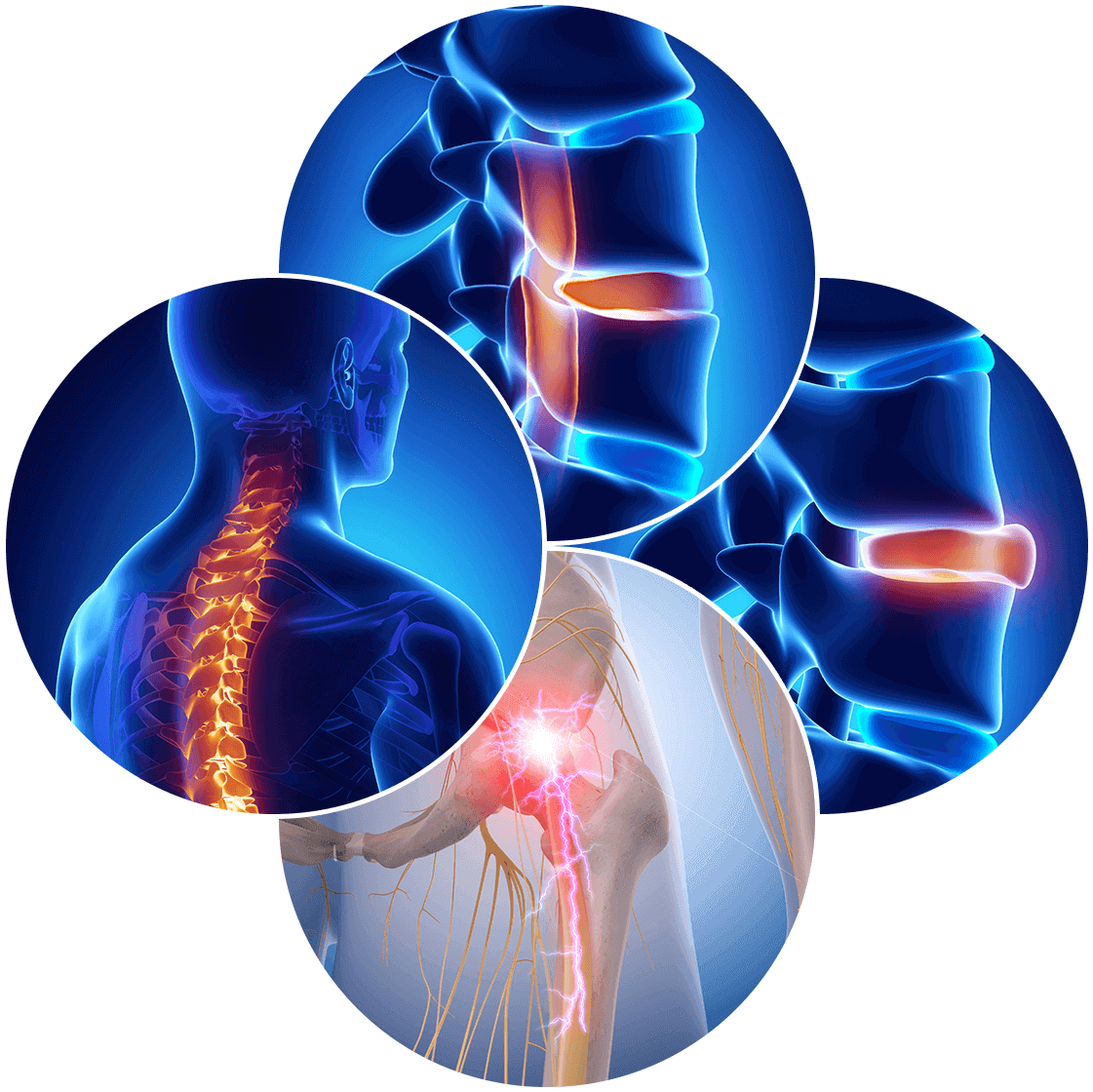Laminectomy Surgery in New Jersey & New York
Get expert treatment for spinal stenosis and other spinal nerve compression conditions with minimally invasive laminectomy surgery by board-certified spine specialists in New Jersey and New York.

What is a Minimally Invasive Laminectomy?
A laminectomy is a specialized spine surgery designed to relieve pressure on the spinal cord and nerve roots by removing part or all of the lamina. The laminae are the bony arches on vertebrae that protect the spinal cord and nerve roots. When these structures become thickened due to arthritis, bone spurs, or other degenerative changes, they can narrow the spinal canal, resulting in the pinching of these nerves.
A laminectomy surgery effectively “opens up” this space, allowing compressed nerves to function properly and reducing pain, numbness, and weakness.
Types of Laminectomy Procedures
- Partial Laminectomy: Removes only a small portion of the lamina to decompress specific nerve roots. This conservative approach preserves spinal stability while targeting the exact source of nerve compression.
- Complete Laminectomy: Involves removal of the entire lamina at one or more vertebral levels. This comprehensive approach is used when extensive decompression is needed for severe spinal stenosis.
- Cervical Laminectomy: Performed in the neck region to treat cervical spinal stenosis, relieving pressure on the spinal cord that can cause neck pain, arm pain, and neurological symptoms.
- Lumbar Laminectomy: The most common type, performed in the lower back to treat lumbar spinal stenosis, providing relief from leg pain, back pain, and walking difficulties.
After removing the lamina, your surgeon may perform additional procedures to ensure nerve decompression. Some of the other procedures that are often combined with a laminectomy include: foraminotomies, discectomies, and spinal fusions (ALIF, PLIF, & TLIF, for example). The specifics of your procedure, however, will depend entirely upon your individual situation and medical needs.
Conditions Treated By A Laminectomy
Laminectomy surgery is recommended when conservative treatments have failed to provide adequate relief from spinal stenosis symptoms. Our spine specialists carefully evaluate each patient to determine if surgical intervention is the most appropriate treatment option.
Common conditions treated by a laminectomy procedure include:
The narrowing of the spinal canal that compresses the spinal cord and nerve roots, causing pain, numbness, and weakness in the legs or arms.
Can cause myelopathy (spinal cord compression) leading to balance problems, hand clumsiness, and progressive weakness.
When a herniated disc occurs alongside spinal stenosis, requiring comprehensive decompression.
Results in neurogenic claudication—leg pain and weakness that worsens with walking and improves with sitting or leaning forward.
Bony growths that develop as part of the aging process and can encroach on nerve pathways.
Failed Conservative Treatment
When physical therapy, medications, epidural injections, and other non-surgical treatments have not provided sufficient pain relief.
Laminectomy Candidacy & Eligibility Requirements
If you have been suffering from the painful symptoms of spinal stenosis or other spine conditions, a laminectomy might be right for you. Ideal candidates for laminectomy surgery have a confirmed spinal stenosis diagnosis and are experiencing significant functional limitations despite conservative treatment.
Candidates for spine surgeries like a laminectomy should also be in good overall health to tolerate surgery. There are certain situations that may restrict an individual from receiving a laminectomy, however. If you have infection of the spine, severe instability in a spinal segment, or if you are diagnosed with a severe medical condition, then a laminectomy may not be the right option for you.
It is always important to have a full assessment and diagnosis, performed by a specialized spine surgeon like Dr. Jason Lowenstein. If noninvasive treatments such as physical therapy and pain management were not adequate to relieve your pain, then it may be time to evaluate your surgical options.
What Our Patients Are Saying
Dr. Lowenstein and team are true professionals. Extremely well versed in overall spine care knowledge. Great experience, never rushed during office visits. He was trained by the best team of doctors at Columbia Presbyterian Scoliosis and Spine in NY of whom I had personal surgery from 25 years ago. I highly recommend this team. You will not be disappointed with their overall care, compassion and direction for your needs.
-Anthony F. ⭐️⭐️⭐️⭐️⭐️
I had issues with my entire spine. It was not an easy fix. Dr. Jason Lowenstein made sure I knew the variables, he even comforted my mother! His staff made sure I had everything I needed for my job and disability insurance. theAdvanced Spine Center is everything I thought was missing from modern medicine. They still care…
-DVS I. ⭐️⭐️⭐️⭐️⭐️
Best thing [I’ve] ever done was to have my back operated on. Everybody at the Spine Center was great. Dr Lowenstein was my surgeon and did a great job on me. I would recommend to anybody who is having back problems to go and see them.
-Tony N. ⭐️⭐️⭐️⭐️⭐️
Our Approach to Minimally Invasive Laminectomy Surgery
At Advanced Spine Center, our comprehensive approach to laminectomy surgery combines cutting-edge minimally invasive techniques with personalized patient care to ensure optimal outcomes and faster recovery times.
Pre-Operative Preparation: We’ll make sure you’re fully prepared and comfortable before your surgery. Our team provides detailed guidelines designed to minimize surgical risks and optimize your recovery.
Anesthesia and Surgical Environment: Laminectomy surgery is performed under general anesthesia in our state-of-the-art surgical suites equipped with advanced imaging and navigation technology. Our anesthesiologists work closely with the surgical team to ensure your complete comfort and safety throughout the procedure. Advanced monitoring equipment tracks your vital signs continuously, while our experienced surgical team maintains the highest standards of sterile technique and patient safety.
Minimally Invasive Surgical Technique and Precision: We begin your laminectomy with a small, carefully placed incision about 1-2 inches long over the affected area. Using gentle, muscle-sparing techniques, we move muscles and ligaments carefully to the side rather than cutting through them. With a clear view of the targeted laminae, we precisely remove the portion of bone that’s compressing your nerves.
Recovery and Immediate Post-Operative Care: Following your laminectomy surgery, you’ll wake up in our comfortable recovery area where our caring nursing team monitors your progress and manages any discomfort. Most patients are pleasantly surprised by how quickly they feel relief from their symptoms.
Why Choose Us for Advanced Spine Care
The Advanced Spine Center in New Jersey is recognized as a leading destination for spine treatment in the nation. Patients choose us for their spine treatment because we offer:

Comprehensive Care
From initial evaluation to post-surgical care, we provide complete spine care. Our multidisciplinary team ensures optimal outcomes for every patient.

Advanced Technology
State-of-the-art imaging, surgical navigation systems, and minimally invasive instruments enable precise, safe spine care with excellent results.

Convenient Location
Easily accessible in New Jersey and New York , our modern facility provides comfortable care in a convenient location. Plus, patients from across the nation, and even world wide, find come to us!
Frequently Asked Questions About Laminectomy Spine Surgery
During a laminectomy, your spine surgeon will make a small incision on the back, adjacent to the affected vertebrae. The number and size of the incisions will depend upon the number of laminae that your surgeon will operate on during the procedure. Your spine surgeon will then move muscles and ligaments carefully to the side, providing a clear view of the targeted laminae. Next, your doctor will remove the lamina through the use of specialized instruments and drills, leaving space for the compressed nerves to expand. After removing the lamina, your surgeon may perform additional procedures to ensure nerve decompression.
Most laminectomy procedures take 1-3 hours, depending on the number of spinal levels being treated and the complexity of the decompression required.
Not all patients require spinal fusion. Our expert spine surgeons carefully evaluate each patient and their specific situation to determine if a spinal fusion is necessary for spinal stability or if a standalone laminectomy will provide adequate treatment.
Choose a board-certified orthopedic or neurological surgeon with extensive experience in minimally invasive spine surgery, like Dr. Jason Lowenstein. Dr. Jason E. Lowenstein, MD, specializes in treating the painful narrowing of the spinal canal caused by spinal stenosis. He is well-versed in endoscopic techniques and has received multiple awards for his expertise in adult and pediatric spine surgery. If you are suffering from spinal or foraminal stenosis, you can trust Dr. Lowenstein and his experienced team at the Advanced Spine Center of New Jersey to help you find relief.
Many major insurance plans cover laminectomy surgery when it’s medically necessary and conservative treatments have been unsuccessful. Our insurance specialists help verify coverage and work with your insurance provider to ensure proper authorization.
The cost varies based on the complexity of the procedure, number of levels treated, facility fees, and your insurance coverage.
Ready to Take the Next Step in Your Spine Care?
Don’t let back pain limit your life. Contact the leading spine specialists in NJ & NY today!
